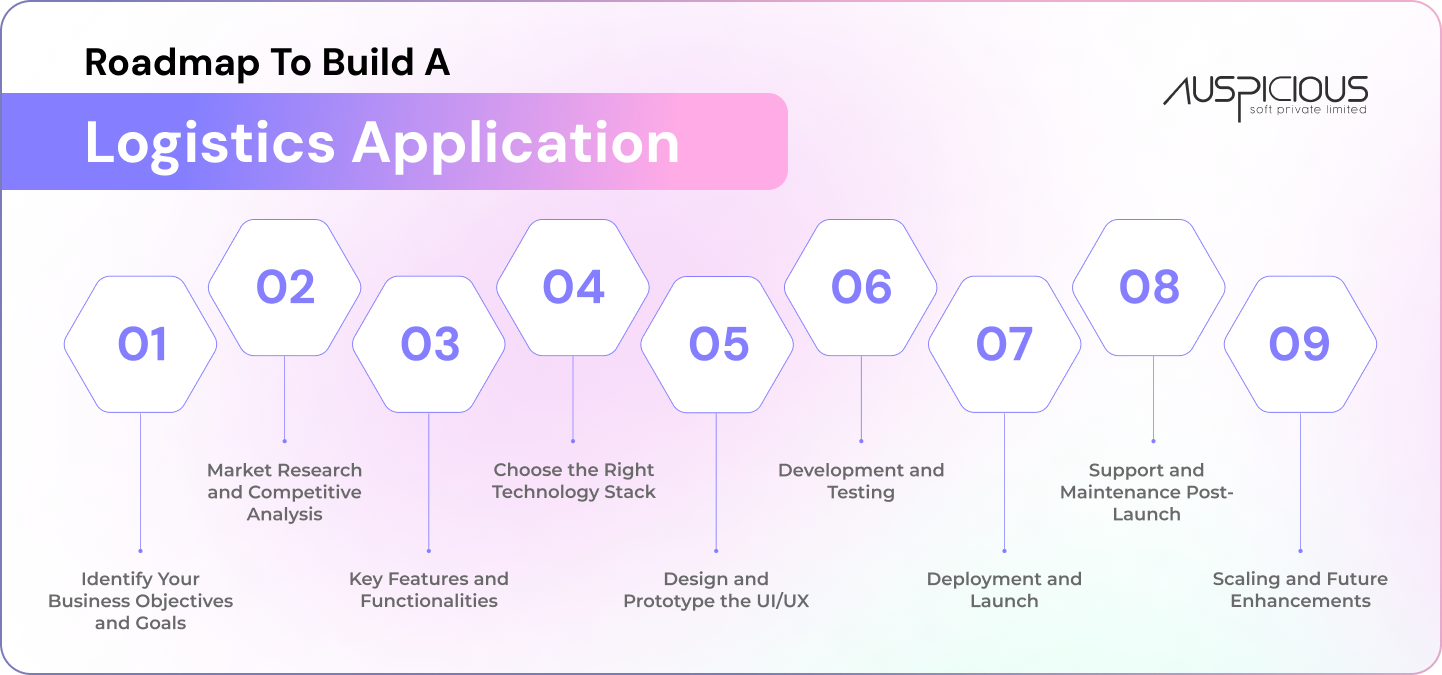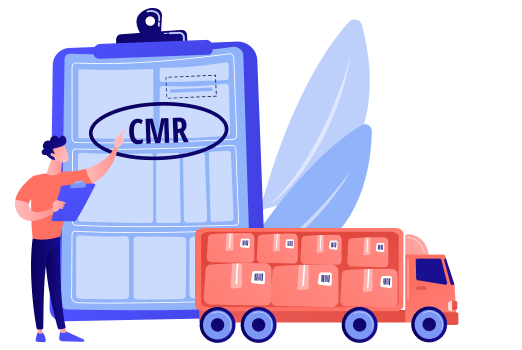Step-by-Step Roadmap to Building a Winning Logistics App
Logistics and transport have evolved exponentially in the present fast-paced digital world. Growing demand for effective supply chain management has resulted in increased on-demand delivery applications. Advanced technology solutions are being availed by businesses to optimize operations, and an aptly designed logistics application can bring in substantial improvement in delivery management, fleet tracking, and customer satisfaction.

As a leading logistics software development company, we have compiled a comprehensive step-by-step roadmap for developing a successful logistics app. Whether you are a startup or an enterprise, this guide will help you navigate the complexities of on-demand delivery apps and create a robust solution tailored to your business needs.
Step 1: Identify Your Business Objectives and Goals
Before diving into logistics software development, it’s essential to define the core purpose of your application. Consider the following questions:
-What problem will the app solve?
-Who is your target audience?
-What key features should the app include?
-How will it integrate with existing logistics systems?
Clearly defining your objectives will ensure a structured approach and help your logistics software development company create a tailored solution that aligns with your business goals.
Step 2: Market Research and Competitive Analysis
Understanding market trends and analyzing competitors will give you insights into the current landscape of on-demand delivery apps. Study industry leaders, their features, and user feedback to identify gaps and opportunities. Look for:
-Emerging technologies in logistics and supply chain management
-Strengths and weaknesses of existing on-demand delivery apps
-Customer pain points and expectations
Through deep research, you can place your app uniquely in the market while giving a premium experience to its users.
Step 3: Key Features and Functionalities
What your logistics application would be hinges on the functionality that you might be adding. Common functionalities that would be integrated into a typical logistics software development company include the following:
Admin Panel:
-Fleet and driver management
-Real-time tracking and analytics
-Automated route optimization
-Inventory and warehouse management
-Payment processing and invoicing
Delivery Agents:
-Order assignment
-Status updates
-GPS navigation and route optimization
-Proof of delivery (e-signature, barcode scanning, photo upload)
-Performance analytics
For Customers:
-Easy booking and scheduling
-Real-time tracking of deliveries
-Secure payment options
-Notifications and alerts
-Ratings and feedback system
These features must be implemented seamlessly to enhance the efficiency of on-demand delivery apps and provide a seamless user experience.
Step 4: Choose the Right Technology Stack
The right technology stack is important for scalability and performance. A good logistics software development company will assist you in selecting the right technologies based on the complexity and requirements of your app.
Recommended Tech Stack:
Frontend: React Native, Flutter, Swift (iOS), Kotlin (Android)
Backend: Node.js, Django, Ruby on Rails
Database: MySQL, MongoDB, Firebase
Cloud Services: AWS, Google Cloud, Microsoft Azure
Payment Integration: Stripe, PayPal, Razorpay
Navigation & Tracking: Google Maps API, OpenStreetMap, HERE Maps
Scalable tech stacks ensure that your on-demand delivery applications are secure, strong, and future-proof.
Step 5: Design and Prototype the UI/UX
User experience will play a big role in the success of your application. A clean, intuitive design will enhance usability and engagement. When choosing a logistics software development company, expect them to create wireframes and prototypes before the development phase to visualize the application layout.
Key things to consider while crafting the UI/UX include:
-Easy navigation and smooth user flow
-Minimalistic and modern design
-Consistent branding
-Mobile responsiveness and accessibility
Prototyping validates the design decisions and ensures the app meets user expectations before proceeding to full-fledged development.
Step 6: Development and Testing
Development involves writing the actual code and integrating all functionalities. This stage is usually broken into:
a. Frontend Development: Creating user interfaces and interactions
b. Backend Development: Building the server, database, and application logic
c. API Development: Connecting frontend and backend components
Testing Strategies:
A good logistics software development company will test the app rigorously to ensure that it is free from bugs and high performance. Testing methodologies include:
Unit Testing: Checking whether individual components work as expected
Integration Testing: Checking whether modules interact seamlessly
Performance Testing: Checking the speed and scalability of the app
Security Testing: Identifying vulnerabilities and data protection issues
Proper testing will ensure that a flawless and high-performing on-demand delivery app is delivered to the market.
Step 7: Deployment and Launch
The final stage after development and testing is to deploy on relevant platforms such as Google Play Store or Apple App Store. The logistics software development company will keep the software compliant with guidelines from those platforms and aid in app store optimization (ASO) for increased visibility.
Key aspects of a successful launch include:
-Marketing and promotional campaigns
-Gathering initial user feedback
-App performance monitoring post-launch
An easy launch strategy ensures your on-demand delivery apps hit and attract early adopters.
Step 8: Support and Maintenance Post-Launch
Development does not end with the deployment. Monitor it continuously, and keep updating with improvement to get it running right. The list of post-launch activity is as follows:
-Bug fixings
-Security patches
-Performance enhancements
-Feature updates by the feedback given by users
-Customer support and troubleshooting
Partnering with a logistics software development company that offers continuing maintenance ensures your application stays competitive with the ever-evolving demands in the industry.
Step 9: Scaling and Future Enhancements
As the business grows, your on-demand delivery applications should as well. Scaling in this context comprises:
-Increasing server capacity
-Adding features
-Improving AI-driven automation
-Integrating advanced data analytics
A scalable logistics app will, therefore, bring long-term success and continued satisfaction of customers’ needs.
Conclusion
A successful logistics app needs to have a structured roadmap and logistics software development expertise. Every step involved, from initial planning to deployment and beyond, plays a crucial part in delivering the product to the customers with quality. By teaming up with a dependable logistics software development company, businesses are able to streamline their operations, enhance delivery management, and improve customer satisfaction.
Contact our expert team today to build an industry-leading on-demand delivery app. We specialize in creating custom logistics solutions tailored to your specific business needs, ensuring a seamless, efficient, and scalable mobile application.
FAQ
1. What is a logistics app, and why is it important for businesses?
A logistics app is a mobile or web-based application that helps businesses manage their supply chain operations, including fleet tracking, order management, delivery scheduling, and real-time monitoring. These apps streamline operations, reduce costs, improve efficiency, and enhance customer satisfaction.
With the growing demand for faster deliveries and optimized supply chains, a logistics app is crucial for modern businesses to stay competitive.
2. What will a good logistics app consist of?
A good logistics app should consist of:
For Admin Panel:
– Fleet & driver management
-Real-time tracking & analytics
-Automated route optimization
-Inventory & warehouse management
-Payment processing & invoicing
For Delivery Agents:
-Order assignment & status updates
-GPS navigation & route optimization
-Proof of delivery (e-signature, barcode, photo upload)
-Performance analytics
For Customers:
-Easy booking & scheduling
-Real-time tracking of deliveries
-Secure payment options
-Notifications & alerts
-Ratings & feedback system
These features allow companies and their customers to monitor the deliveries easily, with a hassle-free logistics system.
3. How long does it take to develop a logistics app?
Development time varies according to complexity of the app, the number of features required, and the technology stack in use. On average, there are these four phases:
Planning & Research: 2-4 weeks
UI/UX Design & Prototyping: 3-6 weeks
Development: 3-6 months, depending on the number of features
Testing & Quality Assurance: 4-8 weeks
Deployment & Launch: 2-4 weeks
A simple logistics app will take about 3-4 months, while a complex one with AI-driven automation will take 6-12 months.
4. What technologies are used in logistics app development?
A logistics app requires a robust technology stack for scalability and security. Recommended tech stack:
Frontend: React Native, Flutter (for cross-platform apps), Swift (iOS), Kotlin (Android)
Backend: Node.js, Django, Ruby on Rails
Database: MySQL, MongoDB, Firebase
Cloud Services: AWS, Google Cloud, Microsoft Azure
Payment Gateways: Stripe, PayPal, Razorpay
Navigation & Tracking: Google Maps API, OpenStreetMap, HERE Maps
The right tech stack will ensure performance, security, and scalability.
5. How much does it cost to develop a logistics app?
The cost depends on several factors, including app complexity, development team rates, and features.
Estimated costs:
–Basic app: $10,000 – $30,000
–Mid-level app: $30,000 – $80,000
–High-end app with AI and automation: $80,000-$200,000+
Hosting, maintenance, and integrations of third-party APIs may be extra on top of that.
6. How can I make my logistics app user-friendly?
The most important thing a logistics app can have is a smooth User Experience (UX). Here are the best practices.
✔️ Navigation should be intuitive
✔️ Minimal clicks are done on completion of tasks.
✔️ Fast Load Time: Speed up your app for best performance.
✔️ Clear CTAs: Ensure all the buttons and actions are well seen.
✔️ Mobile Responsive: Make your app responsive on every screen.
✔️ Testing on Users: Test A/B, and usability test for perfect UX.
Collaborating with an expert logistics software development company would create a UI/UX design seamless to its users.
7. How can I include real-time tracking in my logistics app?
Real-time tracking is essentially a must for logistics operations. You can integrate the following:
-GPS & Geolocation APIs: Google Maps API, OpenStreetMap
-IoT & Telematics: Sensors to track fleet location
-Geofencing: Alerts when a vehicle enters/exits a specified area
-AI-Based Route Optimization: Suggests the best delivery routes
Thus, real-time tracking helps in increasing transparency and assures on-time deliveries.
8. How do I monetize my logistics app?
Monetize your app using the given monetization strategies:
Commission-Based Model: Charge per successful delivery.
Subscription Model: Give premium features by monthly or annual plans.
Advertisements: Use relevant ads inside the app.
Partnerships: Partner with third-party service providers.
Surge Pricing: Charge them more during surge demand.
You can choose the correct monetization method based on your business model and target audience.
9. How do I secure my logistics app?
Security is the topmost priority in logistics apps to secure user data and transactions. Some of the best practices are as follows:
SSL Encryption: Secure data during transfer
Multi-Factor Authentication: Secure user login
Role-Based Access Control: Restricts admin and user permissions
Regular Security Audits: Identify vulnerabilities & fix them
Data Backups: Prevents loss of data due to cyber attacks
Working with a seasoned logistics software development company will ensure industry-standard security measures.
10. Post-launch activities of a logistics app
After the launch of your logistics app, maintenance and improvement are vital. Some key activities include;
Bug Fixes & Updates: The security vulnerabilities and bugs are patched regularly.
Performance Optimization: The speed of the app is checked and slow loading pages are rectified.
Customer Support: 24/7 support to the users and clients.
New Feature Enhancements: Functionalities are upgraded based on user feedback.
Marketing & ASO (App Store Optimization): Promote your app for greater visibility.
Logistics software development companies can support the post-launch phases and scaling up of the application.
TABLE OF CONTENT
- Step-by-Step Roadmap to Building a Winning Logistics App
- Step 1: Identify Your Business Objectives and Goals
- Step 2: Market Research and Competitive Analysis
- Step 3: Key Features and Functionalities
- Step 4: Choose the Right Technology Stack
- Step 5: Design and Prototype the UI/UX
- Step 6: Development and Testing
- Step 7: Deployment and Launch
- Step 8: Support and Maintenance Post-Launch
- Step 9: Scaling and Future Enhancements
- Conclusion
- FAQ
